Abstract
1. Apparatus for applying a step change of length to an isolated muscle fibre is described. The step was complete in about 0·2 ms.
2. Effects of tendon compliance were eliminated by using a spot-follower device and by gripping the tendons with metal clips close to the fibre ends.
3. The natural frequency of the force transducer was above 10 kHz.
4. Steps of various amplitudes and in either direction were applied to isolated muscle fibres about 6 mm long from the anterior tibial muscle of Rana temporaria during tetanic stimulation. Initial sarcomere length was 2·0-2·2 μm, and temperature was 0-3 °C.
5. The tension response to a step could be divided into four phases. The initial response was an apparently elastic change during the step itself (phase 1). After the step was completed there was a rapid partial recovery towards the original tension (phase 2, lasting 2-5 ms), followed by a slowing or reversal of recovery (phase 3, 10-50 ms), and finally a much slower return to the original tension (phase 4). Most of this paper is concerned with phases 1 and 2.
6. The initial tension change (phase 1) occurred synchronously with the applied length change, indicating that the fibres possess a compliance which is almost linear and almost undamped. Its stiffness is such that an instantaneous shortening of about 4 nm per half-sarcomere would bring the tension to zero from its isometric value.
7. The absence of detectable damping during phase 1 indicates that the viscosity of a stimulated fibre is substantially less than the apparent viscosity of a fibre at rest.
8. The instantaneous force—extension curve approached the length axis at a sharp angle and a negative tension appeared at the force transducer when a very large step was applied. These observations suggest that the structures responsible for the stiffness of the fibre remain rigid when they are not under tension.
9. During the few milliseconds after the step (phase 2) the tension recovered part of the way toward the level which existed before the step. In shortening steps the time course of this recovery was adequately fitted by the sum of four exponential terms, and was similar in steps of different amplitude but with a time scale shorter the larger the step. In stretches the slow components were relatively larger than in releases.
10. The tension level, T2, approached during phase 2 depended only on the total amplitude of the step and not on the time course of the length change, provided it was complete in 1-2 ms. The extreme tension reached during a step could thus vary widely without detectable change in T2.
11. With stretches and releases of up to about 3 nm per half-sarcomere this early recovery was almost complete, so that the curve of T2 against step amplitude was nearly horizontal. With larger releases the line curved downwards, reaching zero in a release of about 14 nm per half-sarcomere.
12. When the temperature was raised both the developed tension and the stiffness increased, but the relative increase was greater for tension than for stiffness. The amount of instantaneous shortening needed to bring tension to zero was therefore also increased.
13. A set of empirical equations is given which describe adequately the first few milliseconds of the tension change in response to any imposed time course of shortening.
14. The rapid elasticity and early tension recovery resemble the response of a combination of two elastic components and one viscous component. Reasons are given for preferring an interpretation in terms of an undamped compliance in series with a damped compliance (Voigt element) rather than an undamped elasticity in parallel with a series combination of viscous and elastic components (Maxwell element).
15. The rapid compliance does not correspond to the `series elastic component' of two-component theories of muscle contraction.
Full text
PDF
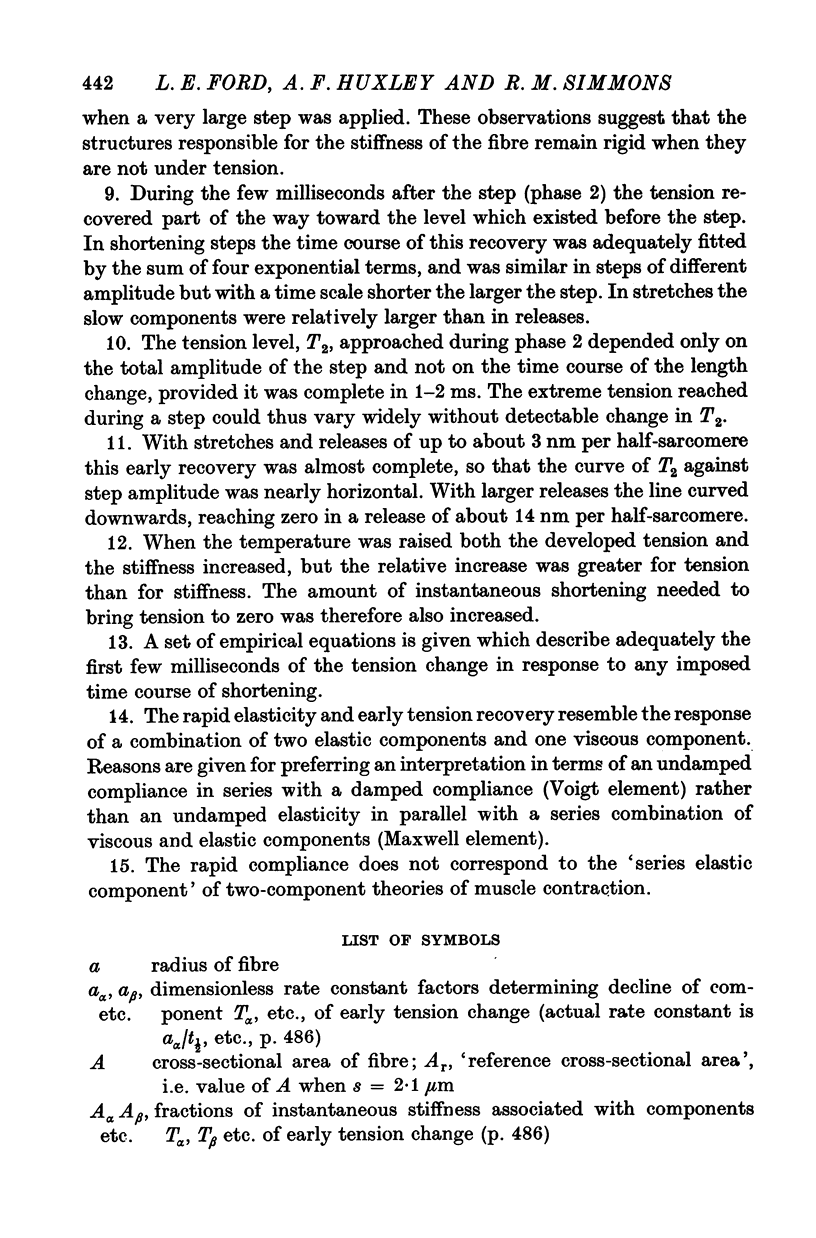

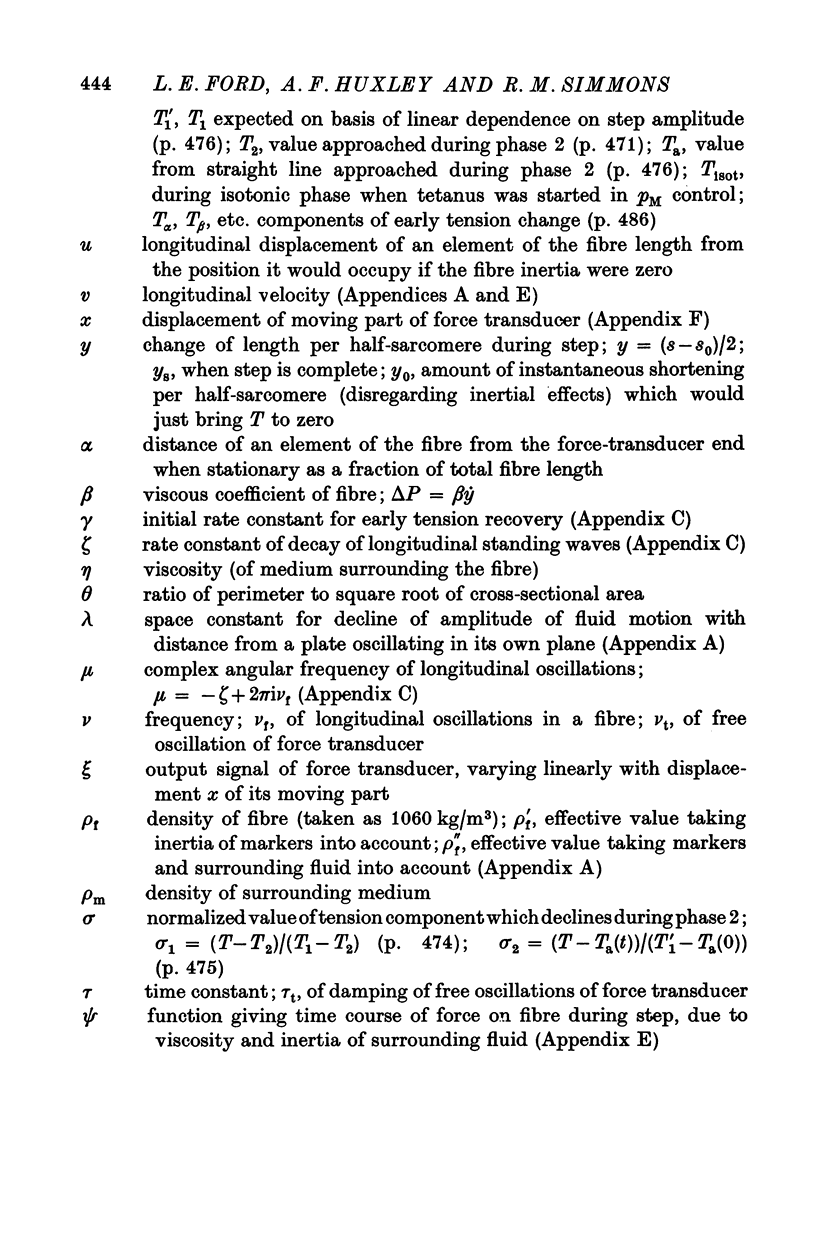




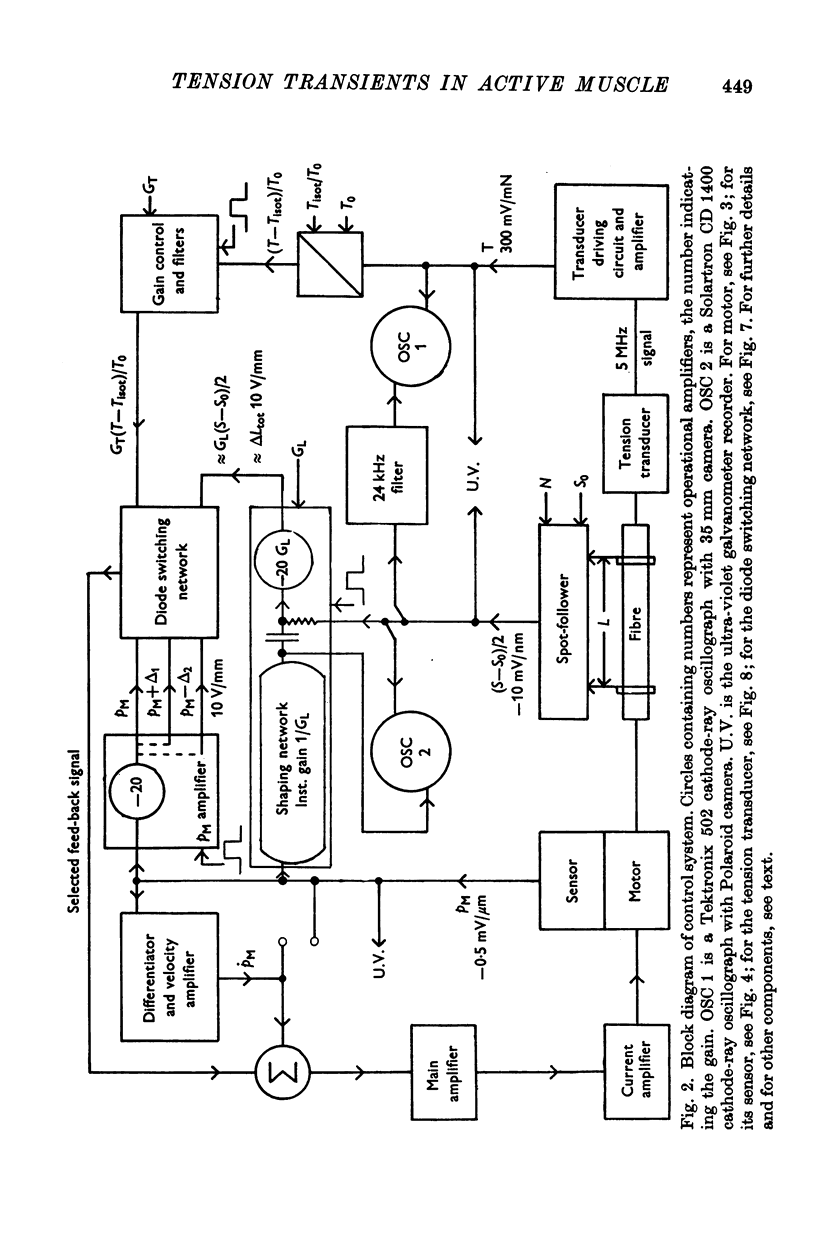




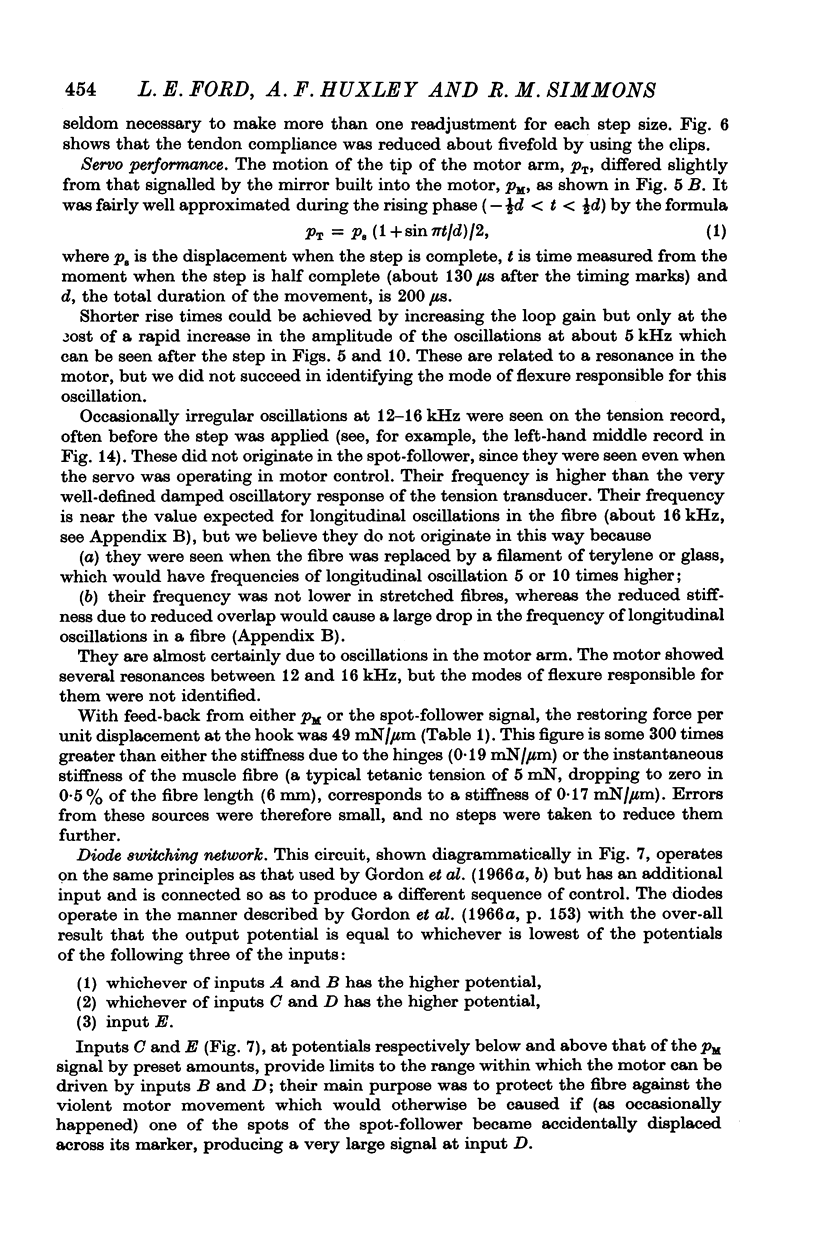



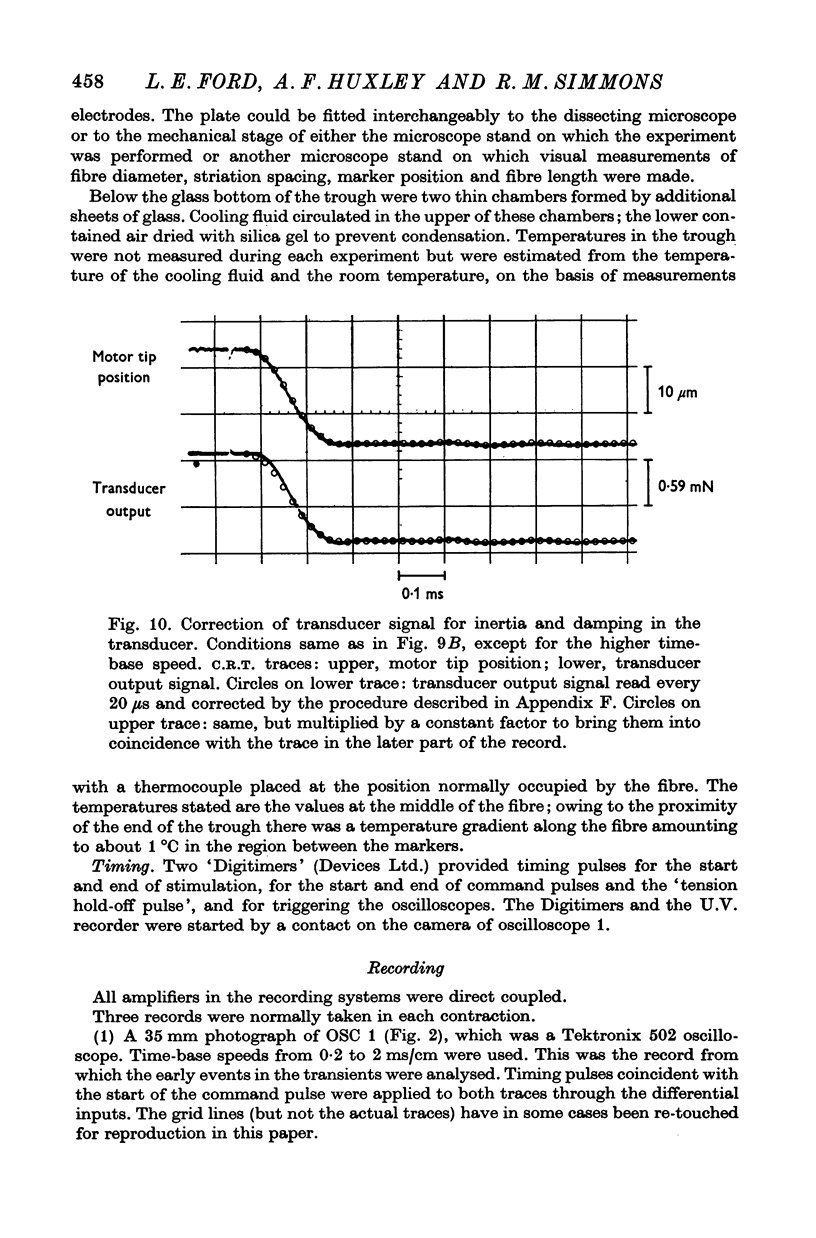










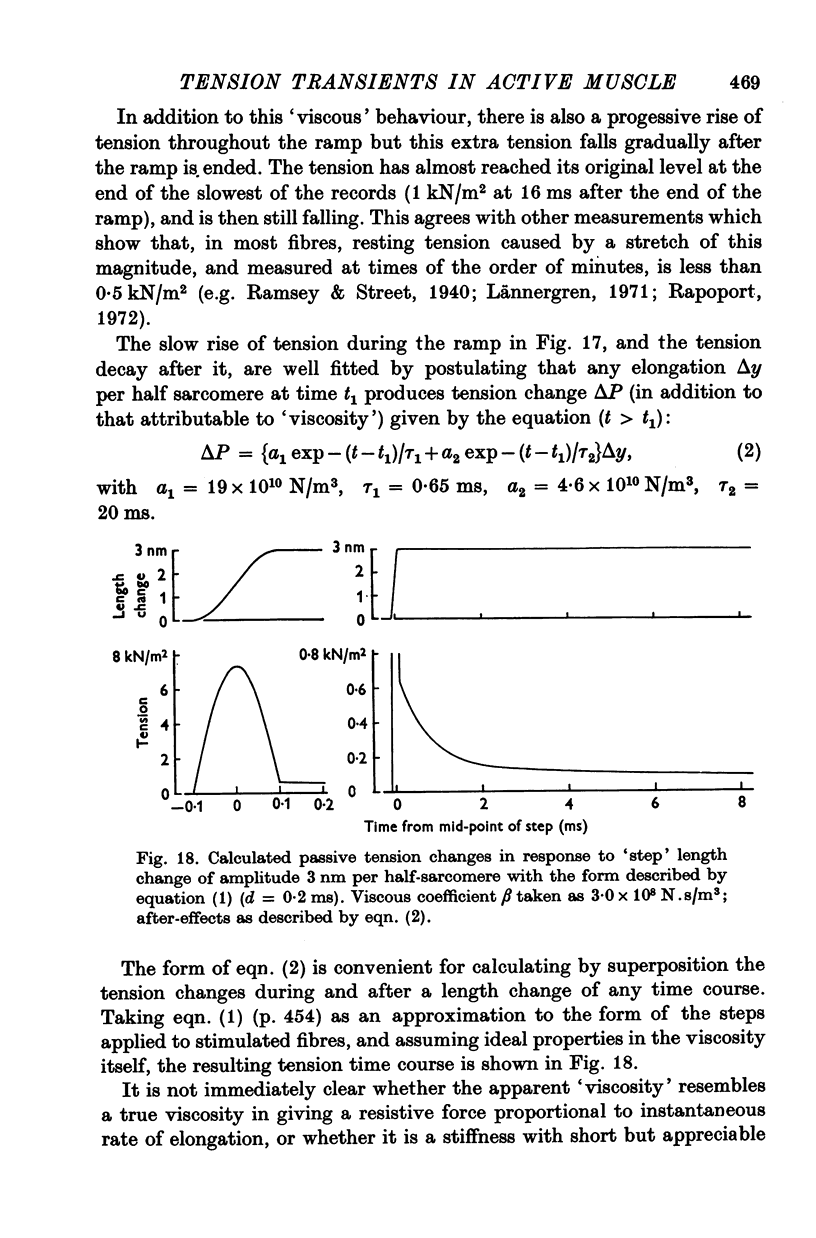
















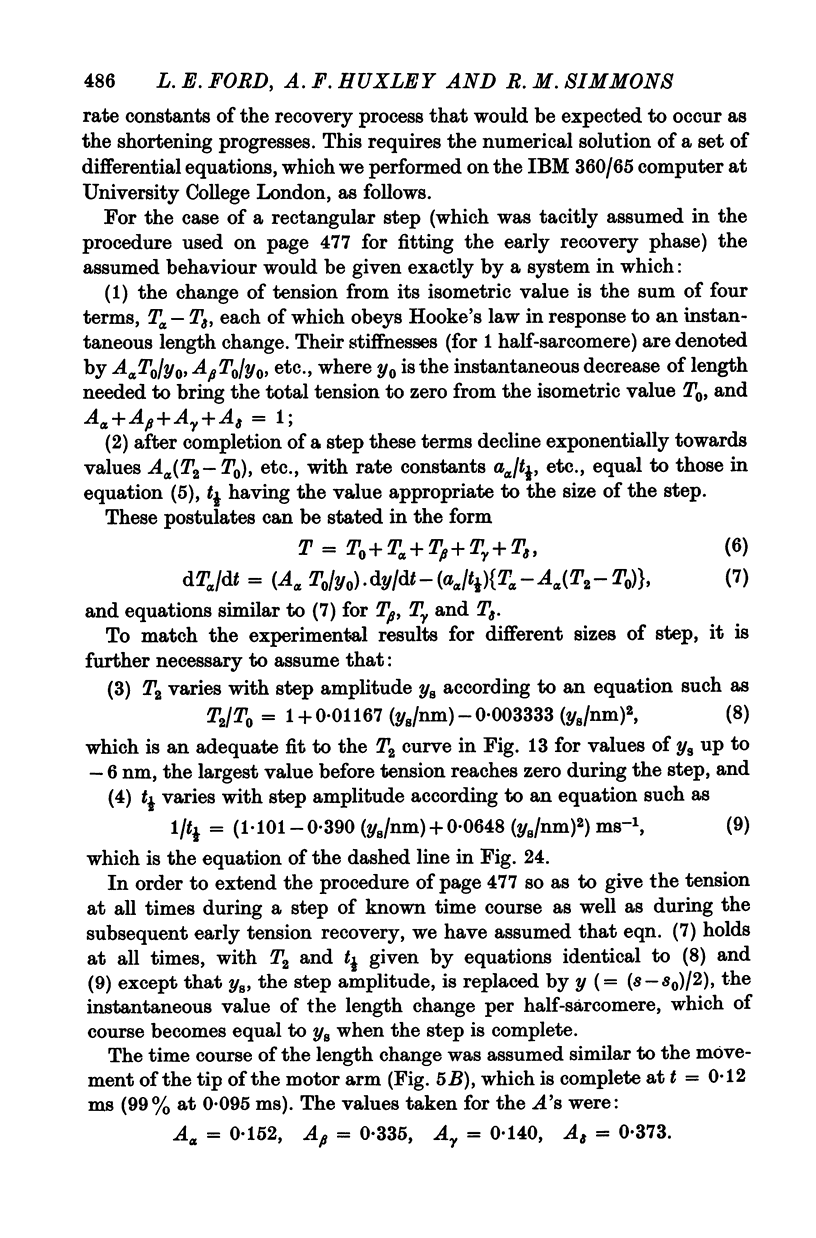







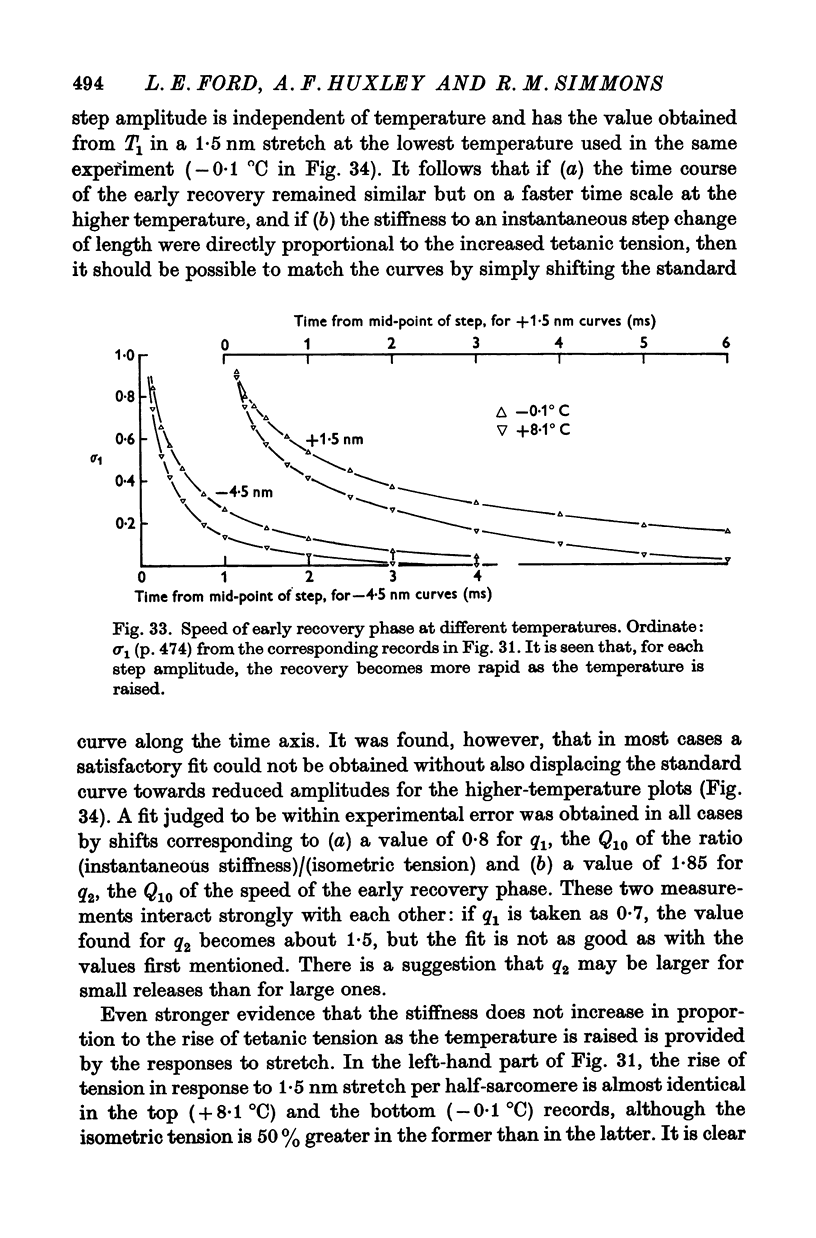

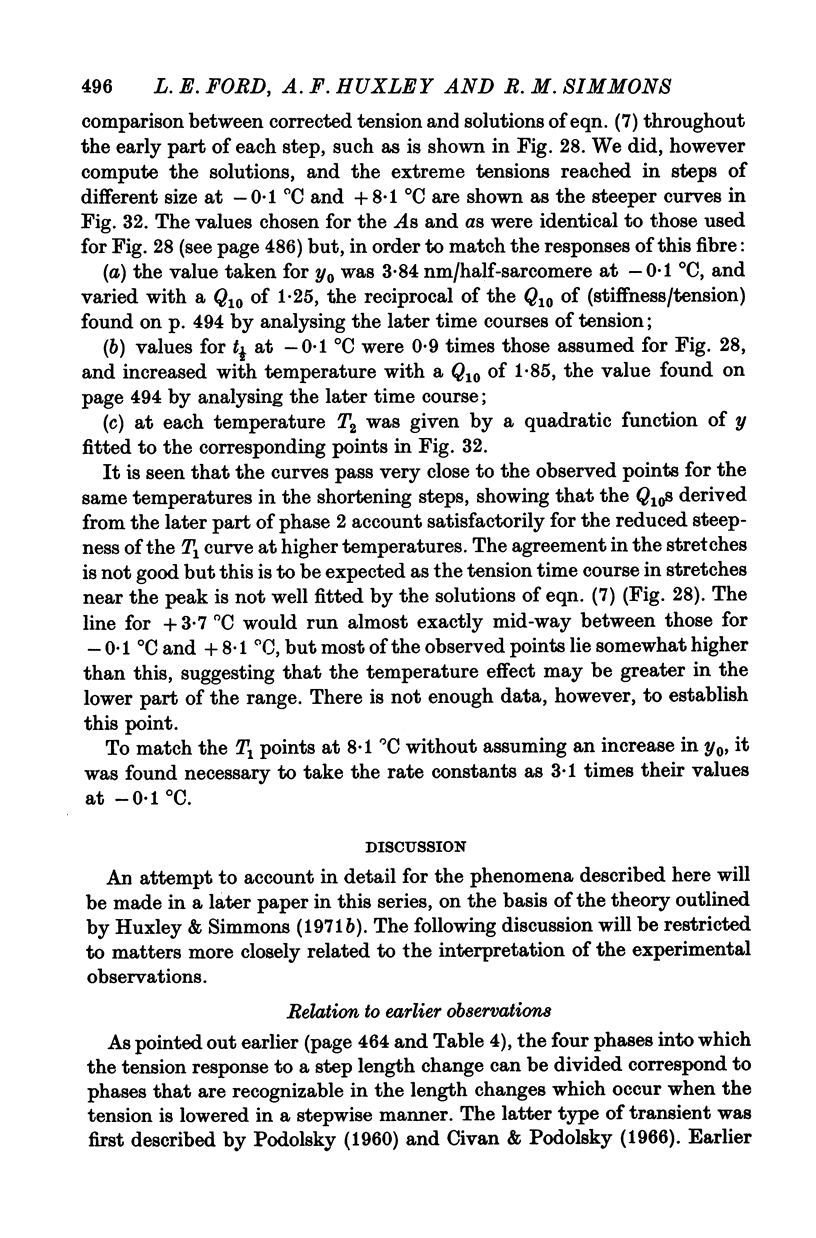









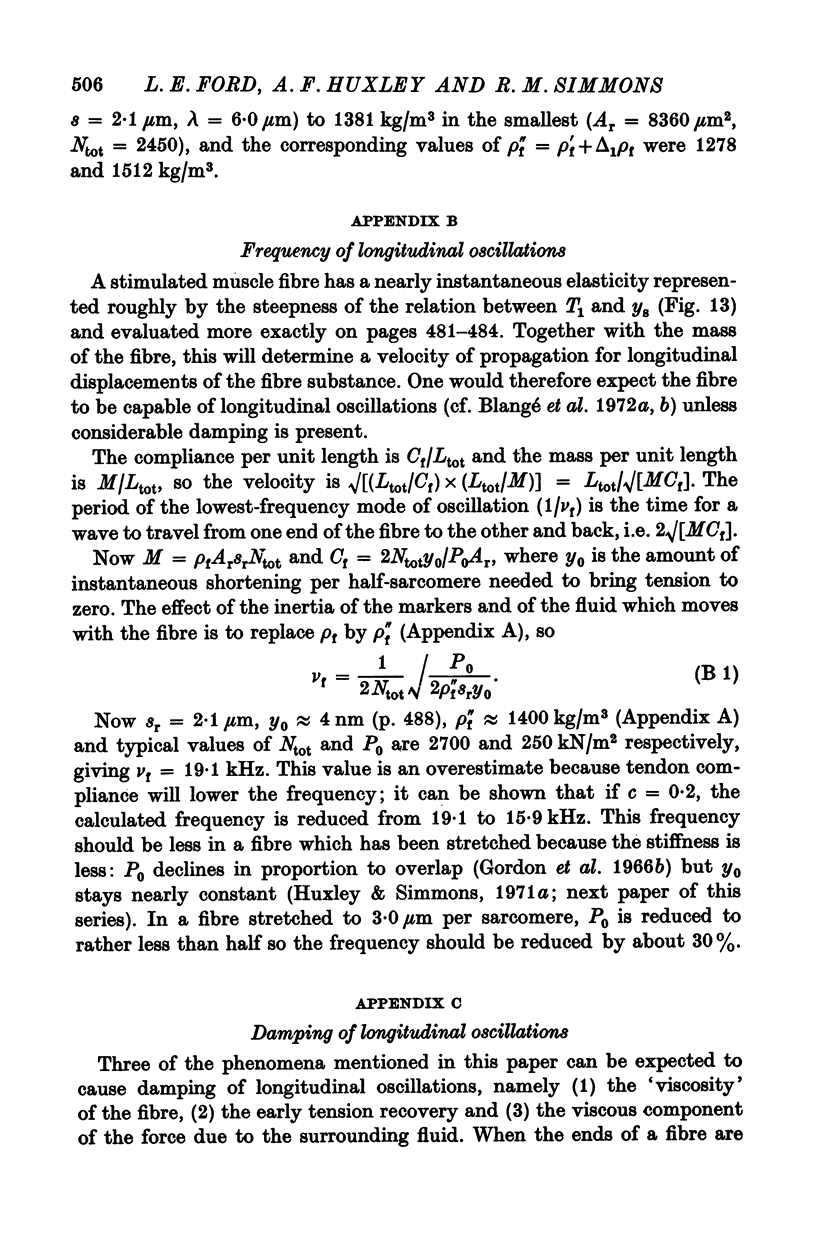









Selected References
These references are in PubMed. This may not be the complete list of references from this article.
- ADRIAN R. H. The effect of internal and external potassium concentration on the membrane potential of frog muscle. J Physiol. 1956 Sep 27;133(3):631–658. doi: 10.1113/jphysiol.1956.sp005615. [DOI] [PMC free article] [PubMed] [Google Scholar]
- Abbott R. H. Comments on the mechanism of force generation in striated muscles. Nat New Biol. 1972 Oct 11;239(93):183–187. doi: 10.1038/newbio239183a0. [DOI] [PubMed] [Google Scholar]
- Blangé T., Karemaker J. M., Kramer A. E. Elasticity as an expression of cross-bridge activity in rat muscle. Pflugers Arch. 1972;336(4):277–288. doi: 10.1007/BF00586953. [DOI] [PubMed] [Google Scholar]
- Blangé T., Karemaker J. M., Kramer A. E. Tension transients after quick release in rat and frog skeletal muscles. Nature. 1972 Jun 2;237(5353):281–283. doi: 10.1038/237281a0. [DOI] [PubMed] [Google Scholar]
- Bressler B. H., Clinch N. F. The compliance of contracting skeletal muscle. J Physiol. 1974 Mar;237(3):477–493. doi: 10.1113/jphysiol.1974.sp010493. [DOI] [PMC free article] [PubMed] [Google Scholar]
- Civan M. M., Podolsky R. J. Contraction kinetics of striated muscle fibres following quick changes in load. J Physiol. 1966 Jun;184(3):511–534. doi: 10.1113/jphysiol.1966.sp007929. [DOI] [PMC free article] [PubMed] [Google Scholar]
- Ford L. E., Huxley A. F., Simmons R. M. Proceedings: Mechanism of early tension recovery after a quick release in tetanized muscle fibres. J Physiol. 1974 Jul;240(2):42P–43P. [PubMed] [Google Scholar]
- Ford L. E., Huxley A. F., Simmons R. M. The instantaneous elasticity of frog skeletal muscle fibres [proceedings]. J Physiol. 1976 Sep;260(2):28P–29P. [PubMed] [Google Scholar]
- Gordon A. M., Huxley A. F., Julian F. J. Tension development in highly stretched vertebrate muscle fibres. J Physiol. 1966 May;184(1):143–169. doi: 10.1113/jphysiol.1966.sp007908. [DOI] [PMC free article] [PubMed] [Google Scholar]
- Gordon A. M., Huxley A. F., Julian F. J. The variation in isometric tension with sarcomere length in vertebrate muscle fibres. J Physiol. 1966 May;184(1):170–192. doi: 10.1113/jphysiol.1966.sp007909. [DOI] [PMC free article] [PubMed] [Google Scholar]
- HILL A. V. The mechanics of active muscle. Proc R Soc Lond B Biol Sci. 1953 Mar 11;141(902):104–117. doi: 10.1098/rspb.1953.0027. [DOI] [PubMed] [Google Scholar]
- HILL A. V. The series elastic component of muscle. Proc R Soc Lond B Biol Sci. 1950 Jul 24;137(887):273–280. doi: 10.1098/rspb.1950.0035. [DOI] [PubMed] [Google Scholar]
- HUXLEY A. F. Muscle structure and theories of contraction. Prog Biophys Biophys Chem. 1957;7:255–318. [PubMed] [Google Scholar]
- Heinl P., Kuhn H. J., Rüegg J. C. Tension responses to quick length changes of glycerinated skeletal muscle fibres from the frog and tortoise. J Physiol. 1974 Mar;237(2):243–258. doi: 10.1113/jphysiol.1974.sp010480. [DOI] [PMC free article] [PubMed] [Google Scholar]
- Heinl P. Mechanische aktivierung und Deaktivierung der isolierten contractilen Struktur des froschsartorius durch rechteckförmige und sinusförmige Längenänderungen. Pflugers Arch. 1972;333(3):213–226. doi: 10.1007/BF00592684. [DOI] [PubMed] [Google Scholar]
- Hill D. K. Tension due to interaction between the sliding filaments in resting striated muscle. The effect of stimulation. J Physiol. 1968 Dec;199(3):637–684. doi: 10.1113/jphysiol.1968.sp008672. [DOI] [PMC free article] [PubMed] [Google Scholar]
- Hill T. L., Eisenberg E., Chen Y. D., Podolsky R. J. Some self-consistent two-state sliding filament models of muscle contraction. Biophys J. 1975 Apr;15(4):335–372. doi: 10.1016/S0006-3495(75)85823-1. [DOI] [PMC free article] [PubMed] [Google Scholar]
- Huxley A. F. Muscular contraction. J Physiol. 1974 Nov;243(1):1–43. [PMC free article] [PubMed] [Google Scholar]
- Huxley A. F., Simmons R. M. A capacitance-gauge tension transducer. J Physiol. 1968 Jul;197(1):12P–12P. [PubMed] [Google Scholar]
- Huxley A. F., Simmons R. M. A quick phase in the series-elastic component of striated muscle, demonstrated in isolated fibres from the frog. J Physiol. 1970 Jun;208(2):52P–53P. [PubMed] [Google Scholar]
- Huxley A. F., Simmons R. M. Proposed mechanism of force generation in striated muscle. Nature. 1971 Oct 22;233(5321):533–538. doi: 10.1038/233533a0. [DOI] [PubMed] [Google Scholar]
- Huxley A. F. The activation of striated muscle and its mechanical response. Proc R Soc Lond B Biol Sci. 1971 Jun 15;178(1050):1–27. doi: 10.1098/rspb.1971.0049. [DOI] [PubMed] [Google Scholar]
- JEWELL B. R., WILKIE D. R. An analysis of the mechanical components in frog's striated muscle. J Physiol. 1958 Oct 31;143(3):515–540. doi: 10.1113/jphysiol.1958.sp006075. [DOI] [PMC free article] [PubMed] [Google Scholar]
- Lännergren J. The effect of low-level activation on the mechanical properties of isolated frog muscle fibers. J Gen Physiol. 1971 Aug;58(2):145–162. doi: 10.1085/jgp.58.2.145. [DOI] [PMC free article] [PubMed] [Google Scholar]
- PODOLSKY R. J. Kinetics of muscular contraction: the approach to the steady state. Nature. 1960 Nov 19;188:666–668. doi: 10.1038/188666a0. [DOI] [PubMed] [Google Scholar]
- Podolsky R. J., Nolan A. C., Zaveler S. A. Cross-bridge properties derived from muscle isotonic velocity transients. Proc Natl Acad Sci U S A. 1969 Oct;64(2):504–511. doi: 10.1073/pnas.64.2.504. [DOI] [PMC free article] [PubMed] [Google Scholar]
- Pringle J. W. The contractile mechanism of insect fibrillar muscle. Prog Biophys Mol Biol. 1967;17:1–60. doi: 10.1016/0079-6107(67)90003-x. [DOI] [PubMed] [Google Scholar]
- Rapoport S. I. Mechanical properties of the sarcolemma and myoplasm in frog muscle as a function of sarcomere length. J Gen Physiol. 1972 May;59(5):559–585. doi: 10.1085/jgp.59.5.559. [DOI] [PMC free article] [PubMed] [Google Scholar]
- Rüegg J. C., Steiger G. J., Schädler M. Mechanical activation of the contractile system in skeletal muscle. Pflugers Arch. 1970;319(2):139–145. doi: 10.1007/BF00592492. [DOI] [PubMed] [Google Scholar]
- Schoenberg M., Wells J. B., Podolsky R. J. Muscle compliance and the longitudinal transmission of mechanical impulses. J Gen Physiol. 1974 Dec;64(6):623–642. doi: 10.1085/jgp.64.6.623. [DOI] [PMC free article] [PubMed] [Google Scholar]
- Steiger G. J. Stretch activation and myogenic oscillation of isolated contractile structures of heart muscle. Pflugers Arch. 1971;330(4):347–361. doi: 10.1007/BF00588586. [DOI] [PubMed] [Google Scholar]
- Truong X. T. Viscoelastic wave propagation and rheologic properties of skeletal muscle. Am J Physiol. 1974 Feb;226(2):256–264. doi: 10.1152/ajplegacy.1974.226.2.256. [DOI] [PubMed] [Google Scholar]


